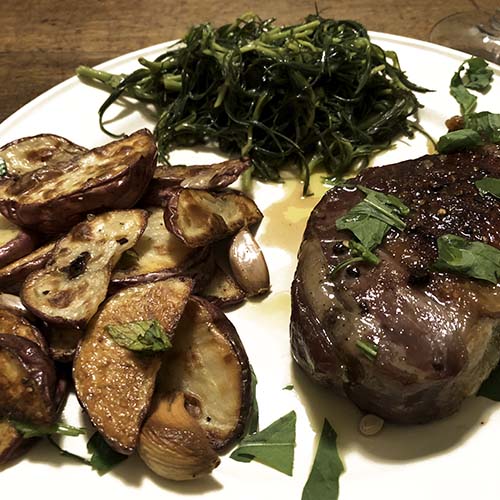
It was the 4th of July.
We were about to enter the fourth month of the Coronavirus pandemic lockdown.
It wasn’t a cookout (it wouldn’t have been a cookout even without the virus), but it was a great steak and there were some luscious oven fries, very very good steak and very very good oven fries. Also some lovely friar’s beard.
I almost always buy locally-farmed meat, whatever the species, but there was good a reason for making an exception this week.
It was a Kansas steak (which seems to have a certain caché). That is, it was a steak from Kansas, specifically, a cut of eastern Kansas Black Angus beef, a prime strip steak, dry-aged. It would normally have been very expensive, but this particular steak, purchased from Eataly, was, at 19 ounces, enough for 2 generous portions, and it was hugely discounted. It cost us only $20, or less than half the conventional price.
I don’t think I had ever cooked a true dry-aged steak, or even eaten one. This may have been my first, but it’s unlikely to be my last.
It was wonderful, from first to last, from the scent that began almost the moment it began to warm in the oven, until the tastiness of the very last bite.
- two 9 1/2-ounce Creekstone Farms Prime Dry Aged New York strip steaks from Eataly, brought to room temperature, seasoned on both sides with local P.E. & D.D. Seafood Company sea salt and some very good freshly-ground black pepper, reverse seared, meaning they were placed on a small metal rack inside an oval La Chamba pan and placed, this time, inside a 275º oven for only about 25 minutes, or until an instant thermometer poked into the center read only 90º to 95º, for an ultimate medium rare, or a bit beyond that, noting that the steaks finish cooking inside a skillet and continue to increase in temperature [I would normally prefer a still lower oven temperature, but I was going to have to juggle the requirement of the steak with that of the potatoes, which would need a 450º oven for about half an hour; in any event I was surprised the steaks cooked so quickly, but the explanation, I now realize, was that they had been dry aged], the steaks then removed, allowed to wait on a warm plate, covered with tin foil, for, say, up to about 45 minutes, which helps in juggling the cooking of the accompanying vegetables, their preparation finished by being placed over high heat on the surface of a very well seasoned small antique cast iron pan that had been coated with a very small amount of cooking oil, an oil with a higher smoke point than olive oil (alternatively a bit of ghee, or a combination of butter and olive oil), (I used Mac Nut macademia nut oil, from Whole Foods Market, by itself), and remembering that the steak was already fully cooked, and only needed to be inside the pan long enough to acquire some color, seared briefly (a minute and a half or 2 minutes on each side), removed from the heat, allowed to rest for up to 10 minutes on 2 warm plates, covered loosely with foil, some lemon juice squeezed on top, the steaks sprinkled with chopped epazote from Windfall Farms and drizzled with a Whole Foods Market Portuguese house olive oil
- three large “red potatoes” from Mountain Sweet Berry Farm, scrubbed, cut into wedges, tossed with a small amount of olive oil, roasted, once the steaks had been removed and the oven temperature increased to 450º, for about 30 or 35 minutes along with some crushed dried aji dulce pepper from Eckerton Hill Farm and several unpeeled mature garlic cloves from Westside Market, finished with a combination of chopped lovage and chopped parsley, both from Norwich Meadows Farm
- 8 ounces of agretti from Willow Wisp Farm, parboiled in a pot of salted water for 7 or 8 minutes, or until the thicker stems had softened, drained, then either heated in a pan with a little olive oil, adding most of the juice from half of a medium lemon, or, once parboiled, merely combined with the olive oil and lemon (in either case, it can be served warm or room temperature, and with the option of a small washed, rinsed, and filleted anchovy)
- the wine was a phenomenal Italian (Tuscany) red, Fattoria Montellori Salamartano Toscana IGT 1998, purchased from the mailing list of New York Vintners

Gladys Swarthout, as Plentiful Tewke
- the music was a very American, neglected mid-century work, Howard Hanson’s 1935 opera, ‘Merry Mount’, in a performance by the Seattle Symphony, conducted by Gerard Schwarz
[the second image is from the Hanson opera’s Wikipedia entry]





